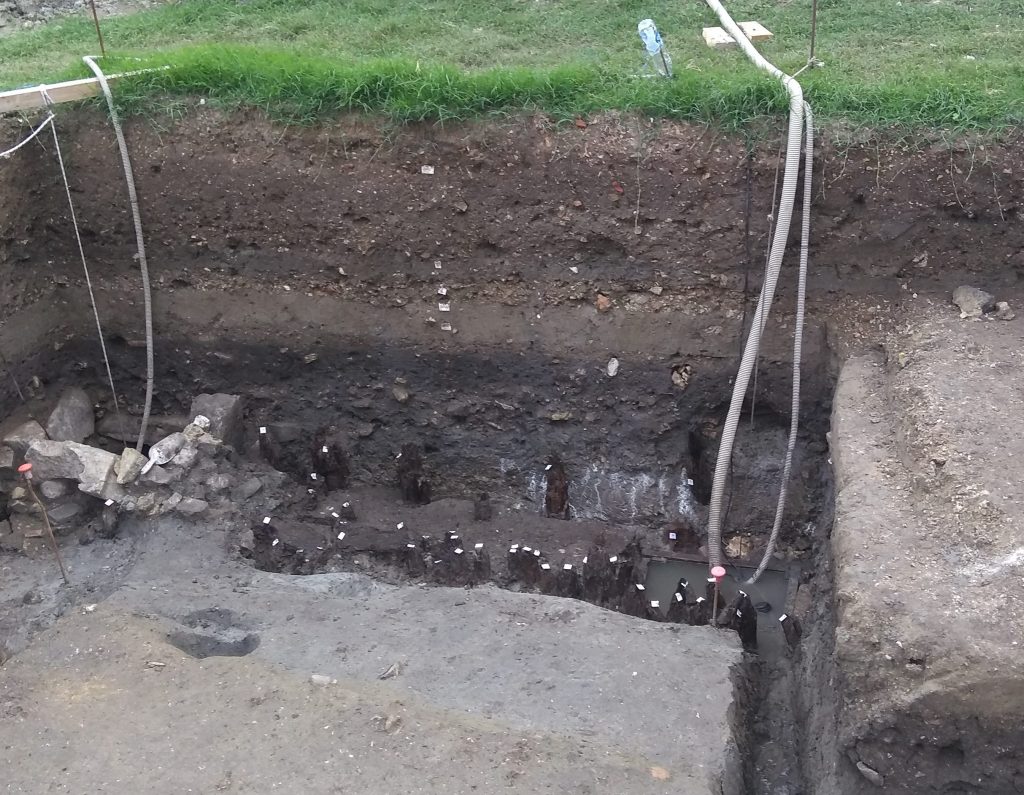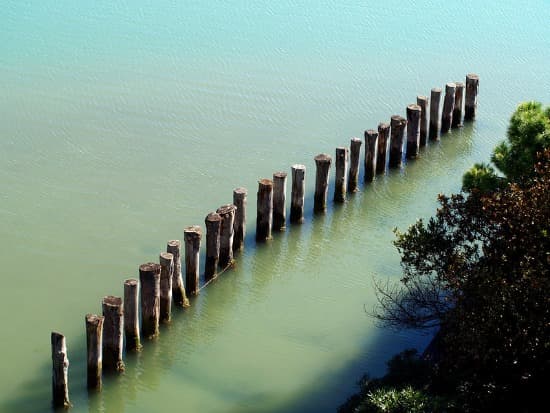How was Venice
built?
How do you build a Metropolis if there’s
nothing to build upon?
How was Venice built?
Just looking at her, walking the
narrow streets, and getting a
Spritz at the bar, you may not
reflect on it all that much. She l
ooks very much like any other
very old city, of which there are
many all over Italy. But if you
could see through the stone
floor, through the pavement
and the bricks, and observe
what is under her, then you’ll
quickly realize that she is
different from any other
medieval city. And it’s nothing
less than a miracle that she is
actually there at all.
The Venice lagoon is all mud.
There is no rock to construct on,
not even soil. So, if you want to
build stone houses and
palaces that weigh hundreds of
tons you have to follow an
ingenious and thorough
strategy. And this strategy will
have to be perfectly adapted
for the very particular circum-
stances in the damp, muddy,
and wet building place.
Venice was built by driving
long pointed poles of wood;
oak, larch, or pine, straight
down into the seafloor. Two
layers of horizontal planking
were laid out. Over that, the
old Venetians put layers of
stone that made up the
foundation of the city. This
technique is ancient, and the
method existed even as long
ago as in the days of the
Roman Empire. The Venetians
just improved and developed it.
The genius of
wooden piling.
The first settlers back in the 5th
and 6th centuries didn’t use this
technique because their houses
were much more basic. They
were mostly made from wood,
and some even from reed and
clay. These houses were light-
weight and the simple sand-
banks were in most cases
enough to sustain them.
In the beginning, the settlers
constructed where there was at
least some ground or soil to
build on. They constructed on
the existing islands, on the
sandbed. But those spots were
few and far apart and twice a
day they got flooded. As Venice
increased its importance, the
city needed more space, so
they had to start building even
where there was no land at all…
They had to find a way to build
directly on the water.
Even later on, the building
technique went from wood and
clay to stone and marble. The
palaces became heavier and
the foundation had to be
stronger. All this made piling
and drainage essential. The
foundation had to withstand
considerable pressure to
prevent the buildings from
simply sinking straight through
the mud. The Romans piled too,
but in Venice, the pilings had to
be suitable for extreme
conditions. So they gradually
increased the length and
number of the wood poles.
Is the so-called hard
floor – Il Caranto.
Here let’s dig further into the
Venetian building strategy. A few
meters down under the bottom
there is a layer of hard clay, the
so-called Caranto. This is a very
fine-grained sediment that has
undergone a process of over-
consolidation in a sub-aerial
environment. This is kind of
technical language but it’s
basically hard mud, and it with-
stands weight better than soft
mud. So if you use woodpiles
long enough to reach the
Caranto it is obvious that down
there, the resistance is greater
than if you just pile down into
the upper layer.
Because the Caranto is not a
hard, flat bottom of stone-like
clay on which the wooden piles
stand. It is not a hard floor that
the architect can use to firmly
anchor the piles. That way of
looking at it is a myth, even
though many locals strongly
believe that Venice is standing
firmly on the Caranto.
The truth is that the Caranto is
found at various levels. It can be
as shallow as two meters and as
deep as more than ten. And it’s
not stone hard. It’s more like a
very dense rubber-like material
that holds the pile better than
normal clay.
We can imagine that the
construction engineer of the
9th and 10th centuries started
with the piles and as work
progressed he put more or less
of them depending on the soil
he was penetrating, in a spiral
motion, from the perimeter and
inward. He knew from the
resistance if the clay was hard
or soft. And if the Caranto
wasn’t reachable, he simply put
the piles closer to sustain the
weight. Because it must have
been very difficult to determine
the structure of the material 5
meters down into the seabed,
before starting the project.
Piling into the upper
layer.
So, if the Caranto was reason-
ably shallow, the piling was
done in a certain fashion,
always in a spiral movement
from the perimeter inwards.
But if they couldn’t reach the
Caranto, the technique changed
into what is called soil
compaction. This is a process
where mechanical pressure is
used to compress the soil thus
making it more sustainable. It
practically turns the soft mud
into hard mud. In this case, the
piles were planted over the
entire surface, first closing the
perimeter, with thick piling. Just
as before, they placed the piling
in a spiral movement inwards,
but in this case, with no space
between the poles.
As the pressure is much greater
under the outer walls, that’s
where the highest number of
poles is if they reached the
Caranto, or the longest and
sturdiest in case of compaction.
Many buildings in Venice stand
on the Carranto, but others do
not. And it was in no way
required to construct a strong
and solid foundation.
How to build a
foundation that can
support a city like
Venice.
To sustain this fact, we just
have to consider that for some
of the bigger buildings in the
city, the Rialto Bridge, Basilica
della Salute, and others, the
documentation is rather
complete. At least the financial
situation, and in the records we
(in Italian). There were many
types of poles, each with its own
nomination, and they should be
around 5 or 6 meters (16 – 20
feet) in length… Some, are a bit
shorter. Just the fact that they
were ordered in a certain
dimension before initiating the
building site, shows that the
project was in no way depending
on the depth of the Caranto, or
if it could be reached.
The length of the poles also
varies through the centuries.
When Venice started out in the
800 and 900, some poles were
as short as a meter or a meter
and a half. This obviously
causes less stability to the
building on top of them.
The collapse of the
Saint Mark’s
Bell Tower.
When the Saint Mark’s Bell
Tower came down one tragic
morning in July 1902 it opened
for the possibility of investigating
the foundation of one very old
building. The tower had been
renovated and overhauled on
various occasions but the
foundation was, and partly still
is, from the 10th century.
What they found was that the
length of the poles was 4
meters. The horizontal planks
and the stone layers mounted
to around 3,5 meters. The
foundation was largely intact
and it was not the settling of
the ground that had caused the
collapse of the tower. The wood
was mineralized and had
practically turned into stone.
Most of the underlying wood-
piled ground in Venice today is
from the 15th and 16th
centuries.

So how did they put
them in place?
Without hydraulic pumps and
steel cranes, getting the poles
down into the mud probably
was a bit of a problem. And this
probably was one of the reasons
why they were so short in the
beginning. This was a job
mainly done by hand, at least in
the first centuries. Building
large mechanical machines
wasn’t only difficult because we
are in the early days of the
Middle Ages… But also because
there wasn’t any ground to put
them on. Remember that in the
beginning the piling often had
to be done where there was
absolutely nothing to stand on.
The method was to just stand
one on each side of the top of
the pole with a heavy thingy in
between hammering on top of
the wooden pile. It was a tire-
some and dangerous job. As the
years went by they invented
heavier and more automatized
machines that could pile deeper
and faster. But it was still labor
for those without a family name,
background, and education.
And it wasn’t only piling that was
time-consuming. The whole
process of building with drain-
ing, and digging, was dangerous
and hard work. But time and
cheap labor wasn’t an issue in
the Middle Ages.
Still, there is not one building in
Venice standing straight up.
Most medieval cities do not
have a perfectly horizontal
foundation but none is as wavy
as Venice. It makes sense if
you consider that she’s actually
floating on top of the water. If
you ride the ferry boat from
Tronchetto to Lido and watch
the bell towers as you pass
through the Canale della
Giudecca, you will notice that
they are all leaning. Some
dangerously so.
How was Venice built?
The floating city
This picture is from an
excavation in Torcello. The
foundation is from the 6th
century and you can see the
wooden piles are all there, more
or less intact. This was the
“fondamenta”, the quay, and it
has slightly more poles than the
surrounding buildings. If they are
left in the open, they will
decompose in a very short time.
On top of the piles, there were
two horizontal layers of thick,
cross-plied wood planking, and
on top of that the bricks and
stones. The part of the
foundation standing against the
water of the canal is made of
Istrian stone, a dense type of
impermeable limestone (by
seawate)r from the peninsula
of Istria on the Croatian side,
opposite Venice.
The outer wall is also conical to
better withstand the weight of
the building. The Istrian stone
reaches from the canal bottom
to above the highest level of
high water to protect the inside
of the ground from direct
contact with the water.
So, why don’t the
wood piles rot?
Because they’re stuck into the
mud. And inside the sludge, the
air doesn’t have access. The
wood has no contact with
oxygen and the microorganisms
doing the decomposition just
can’t work. Instead, the minerals
from the humidity make the
wood harden. Something that
became obvious at the Saint
Mark’s Bell Tower collapse in
1902., The wood underneath
was in more or less perfect
condition… after a thousand
years. And they had turned into
stone.
Actually, it was decided to leave
the original ground when
building the new tower and
enlarge the pilings with 3100
new poles around the base. The
central part of the foundation
under the tower has been there
for more than 1000 years and
it’s still perfect.
How Venice was built
is no less than
a miracle.
The miracle of the city floating
in the lagoon comes from a
combination of ingenious
workmanship, a natural
environment, and hard work.
But it’s not a fixed technique.
Throughout history, Venice has
frequently come up with
adjustments to the building
technique. Some were improve-
ments, while others were not.
And research is ongoing. New
ways to build and maintain the
palaces in Venice are invented
on a daily basis. We have better
knowledge today and more
precise instruments. We lack
cheap labor though and some
old knowledge is getting lost.
The economic factors are
increasingly important. Very
often it’s a balance between
doing what’s best and paying
the least. Like the cleaning of
the canals. That is nowadays
made in a much cheaper way,
but a way that is less thorough.
Venice is still floating, though,
Her nose tip is still above the
waterline, even if the problems
with humidity, cracks, settling,
and the ever more frequent
high waters, are threatening her.
Will she still be here a thousand
years from now? I hope so. But
even though the immediate
problem with high water could
have been solved, for now, by
the MOSE lock gates, there still
is one big future threat that
doesn’t have anything to do
with the wood planks, the Istrian
stone, or the piling… A threat
that is scary and not in any way
tied only to the future of the
lagoon city. The rising sea
levels.






No comments:
Post a Comment